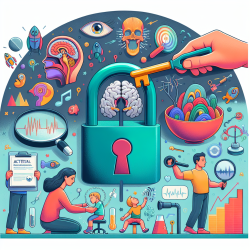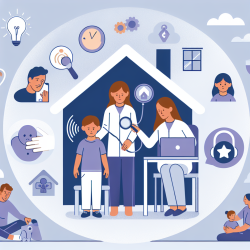Introduction
In the realm of pediatric speech-language pathology, the integration of cutting-edge research with clinical practice is essential for optimizing outcomes. The recent systematic review titled "Study of the Brainstem Auditory Evoked Potential with Speech Stimulus in the Pediatric Population with and without Oral Language Disorders" provides critical insights into how brainstem auditory evoked potentials (BAEP) can be leveraged to better understand and address language disorders in children.
Understanding BAEP-Speech
The brainstem auditory evoked potential with speech stimulus (BAEP-speech) is a powerful tool for assessing how speech sounds are processed in the brainstem. This method allows clinicians to observe the acoustic properties of speech formants as they are preserved in brainstem responses. By doing so, BAEP-speech provides valuable information on how syllables are encoded by the auditory system, offering a window into the neural capacity for processing speech sounds.
Key Findings from the Systematic Review
The systematic review analyzed 14 studies conducted between 2008 and 2019, focusing on children with and without oral language disorders. The studies revealed distinct patterns in BAEP-speech responses between these groups:
- Children with specific language disorders exhibited greater latency delays in the sustained portion of the response, lower amplitude values, and reduced VA complex slope.
- Children with phonological disorders had higher values in the transient portion of the responses.
- Overall, children with language disorders showed different BAEP-speech response patterns compared to typically developing peers.
Implications for Clinical Practice
The findings from this review underscore the potential of BAEP-speech as a diagnostic and intervention tool in clinical practice. By identifying distinct neural response patterns associated with various language disorders, practitioners can tailor interventions more precisely. This approach facilitates early and targeted interventions, which are crucial for improving long-term outcomes in children with language disorders.
Encouraging Further Research
While the review highlights the promise of BAEP-speech, it also points to the need for further research to establish normative data and refine assessment protocols. Practitioners are encouraged to contribute to this growing body of research by conducting studies that explore the nuances of BAEP-speech responses in diverse pediatric populations.
Conclusion
Incorporating BAEP-speech into clinical practice offers a data-driven approach to understanding and addressing language disorders in children. By leveraging the insights from this systematic review, practitioners can enhance their diagnostic and intervention strategies, ultimately unlocking the potential for improved communication outcomes in the pediatric population.
To read the original research paper, please follow this link: Study of the brainstem auditory evoked potential with speech stimulus in the pediatric population with and without oral language disorders: a systematic review?










